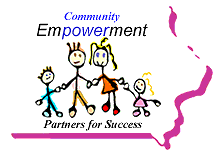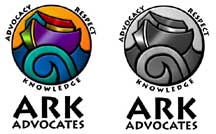
|
The
Logo Project
|
Using research to determine look and feel for a new client |
|
This is an individual project. You are working alone. This is an ideas competition not an art contest, however, there will be rewards for the best concept and design. You can work out your logo in PhotoShop, or you can sketch out your ideas on a piece of paper if you are more comfortable with that. |
Online and Other Resources |
| 1. What do you know about the client? The process of discovery | |
|
What is Empower Dubuque? It's the local chapter of a statewide initiative in Iowa under the title "Iowa Community Empowerment." The Iowa Community Empowerment Initiative was established by legislation during the 1998 Iowa legislative session in an effort to create a partnership between communities and state government with an initial emphasis to improve the well-being of families with young children. The local organization is designed to establish and advance the objectives and goals of the entire initiative. The local contact person for this project is Maryann Yunt, a community leader and advocate for early childcare programs. Important things to learn early about the client and the project: Are there legacy graphics, colors, type styles, or mascots? Any symbology at all which we may have to involve in this project? How will the decision be made as to what logo prototype they want us to pursue? How will the review take place? Who is in charge of approval? Who is ultimately in charge of working with us? Who will have FINAL approval? What is the deadline for alpha prototype and ultimately final delivery of product? There may be some event or roll-out the client has in mind. We need to know what that is, and work the production schedule backwards from that date.
|
The State organization has a logo, but it doesn't seem to inspire enthusiasm locally from what we've gathered so far. The logo is above. Many on the local committee like the drawings of the family, but they are really wanting to develop their own unique look, and that's why they contacted us.
|
|
Questions you should ask the client at the first meeting: 1. Do you want your look to be totally unique or do you want a look that is evocative of other companies in your market? Usually, when faced with this question, the client will almost always respond, "I want to look unique." Don't settle for that answer. You must continue to probe. Respond by saying, "Okay, good! But I have to ask, are there certain colors we should avoid using when prototyping your logo?" This may sound like an innocent question, but it isn't. Color is a very emotional issue with many of us. "Avoid primary colors," was the response from a publishing house that marketed to secondary education customers (primary colors say k-6 education). "No pastels," said the marketing manager of a firm that was seeking federal government contracts, namely defense contracts. "I want my logo to look not exactly like but similar to the number one competitor in my market," said one executive who felt she fully understood what played a respondent chord with her company's target audience. "My brand must look like it belongs with our competitors in our market." 2. What's our budget? I put this question number two so we don't appear to the client that we are solely motivated by money (even if we are). We need to impress the client that we want his business because we love his business. The money and rewards will logically come as we do a good job for the client. On the other hand, nothing moves down the track without wood firing beneath the boiler, and that wood is another term for cash. You need cash for compensation and to propel the project forward. Nothing happens without addressing the money issue. Believe me, unless the client is on a total fishing expedition, they know what they have to spend before they talk to you. And what about this particular client, Empower Dubuque? Since this is a class project, there is a Latin term that applies: "Pro Bono." Every design firm or advertising agency should have a percentage of pro bono clients. It serves two purposes: It serves the company's altruistic mission, allowing your firm to become a good corporate citizen. Second, it provides an opportunity to be much more creative. You can actually make that a condition of accepting the job... "full creative freedom." 3. What do you want and when to you want it? This is the old "deadline" question that puts the ball in the client's court. We call this question the "closer" because it motivates the customer to commit. A deadline is a deadline, and we need to know or negotiate when that is. Then we need to establish our list of deliverables which are assigned to a production schedule that we can't establish unless we have the ultimate deadline. Without a deadline, there is no motivation for closure, and we can't establish intermediary project deliverables and approval points. 4. Who is part of the approval process? Approval points (discussed in item 3 above) are logical breaks in the design and production process where the client can approve what has taken place. Approval points are also good times to ask for installments on your compensation. More on this in a later discussion on compensation issues and how to charge a client. Meanwhile, you need to know who has the ultimate authority in the creative process, and you want to avoid having to design by committee. If your client representative has enough power and confidence, your best case scenario is that you have one person to work with and not several which can only muddy the waters, delay the whole process, and degrade the work. |
|
| 2. Okay, we know who our client is, but who is our audience? To whom does this logo have to strike a chord? | The purpose of creating the community empowerment initiative is to empower individuals and their communities to achieve desired results for improving the quality of life for children 0-5 and their families. |
|
From the Web site and other materials you have digested by now, you should have a good idea as to whom this logo must be appealing. And consider that organization for whom you are developing the logo is Dubuque, Iowa based, should you be thinking of some local symbology, or, is the fact that you are using the name "Dubuque" in the logo sufficient? |
|
|
3. How will the logo be used? Stationery? Business Cards? Signage? Outdoor Advertising? Embroidery? Screen Printed Tee-shirts? Web Site? Multimedia? Video? These applications determine the size and scale the logo must be to be effective. General rule: If it looks terrific on a business card, it will likely work well in an embroidery application. Too much detail that can be seen in a small scale version of your design will be impossible to reproduce in an embroidery application. Always ask the question, "How will this logo resolve at all the sizes it has to be in the client's chosen media forms. If the logo is designed for multimedia, video, or animation, what are the animation opportunities with the logo design? |
http://www.garyolsen.com/kirchhoff/index.html http://www.dubuque.k12.ia.us/DCSDLogoset
If your logo is going to be used in an animation, how would this logo likely be animated?
|
|
4. The most important consideration before you put pencil to paper or cursor to screen is how this logo will be used by the organization? What's their ongoing operating budget for printed materials? Will it support full color? Should we do a full color logo and a limited color logo? How small will the logo be in some applications? Business card size? How will it embroider on a garment like a shirt... over the pocket? |
http://www.garyolsen.com/client11.html |
| 5. The Alpha Prototype: Selling the client on our concept | |
|
How do we sell the client on our vision? It takes three ingredients: 1. Present a solid concept in which you have absolute confidence and unabashed enthusiasm 2. Present quality visuals. Don't hand the client a drawing on a napkin from a fast food restaurant and say here it is. Go the distance with a PowerPoint program, and have hard copies of the logo samples the client can take back to the office. Make sure the samples are clean and mounted on Foamcore board (preferably black), and with cover sheets and your firm's logo engraved on the cover sheets or on stickers displayed tastefully on the cover sheet. 3. Totally control the environment in which the presentation is being made. Doors closed to the conference room or the office, and know everyone in the room and the effect they have on the client. What is their relationship to the client? If the client wants to invite more people in to view your pitch, make sure you get everyone's name before the pitch, and their area of responsibility in the organization. 4. Have a Web site that supports the graphic design concept so the client can share it with a wider circle of colleagues. |
Four Rules that Every Designer should tattoo somewhere on their body, preferably somewhere they can easily see them. 1. Never show a sample that you are not happy with. Chances are the client will pick it. So don't use a dumb idea to enhance the idea you would like to sell the client. 2. Don't provide too many choices because it will only confuse the client. You must limit your concepts to your best two or three. Really good designers with established reputations only submit one... their very best, with the implied assumption that all the screening has taken place on behalf of the client so we can move forward expediently. 3. Never, never, never, NEVER put yourself in a position where you apologize for a marginal concept or execution (i.e.: I'm sorry my color printer ran out of cyan and so this logo should be more blue"). "I didn't have enough money to take this to the service bureau to get a really good copy, but I think you get the picture." The picture the client gets is that you are unprepared, lack the resources to do the job, and you are unsure of yourself and your capabilities." 4. Let your client talk and air their opinions and ideas. Don't marginalize your client's ideas or creative input. It may be the only reason they hired you is because you have the ability to make the client's idea a reality because they lack the experience to put their own ideas on paper. Find out if this is the case, and it will save you a lot of time and effort. Hot shot designers with big egos tend to be confrontational and abusive to their clients in the course of negotiations. This works sometimes, but mostly it's unproductive, and you lose the client. See below:
|
| SEE THE STUDENT GALLERY OF IDEAS THAT WERE SUBMITTED FOR THIS PROJECT. | |
 elcome
to the Logo Project Assignment. Your task is to design a prototype
of a logo for a local chapter of a statewide educational initiative
called "Empower Dubuque." If you follow the individual
steps outlined on this page, you should be developing a graphic
design concept for a logo in very little time.
elcome
to the Logo Project Assignment. Your task is to design a prototype
of a logo for a local chapter of a statewide educational initiative
called "Empower Dubuque." If you follow the individual
steps outlined on this page, you should be developing a graphic
design concept for a logo in very little time. 

